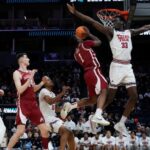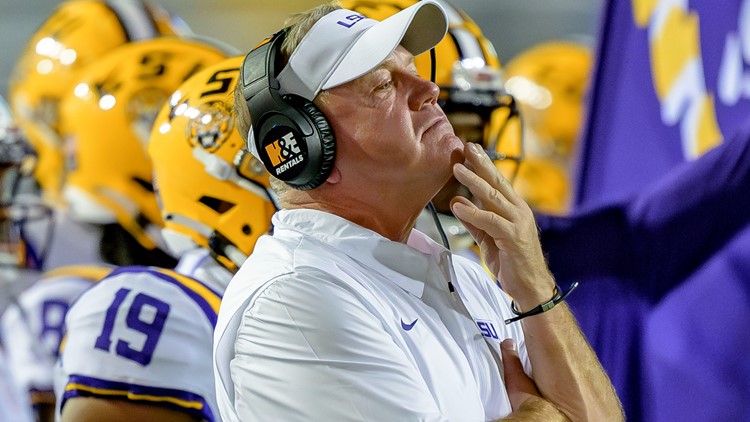Has the pain of losing a home game to BYU worn off? Well, ready or not, Arkansas starts SEC play with a brutal road trip to Baton Rouge.
LSU was a preseason top-5 team due to a ton of returning stars, but an awful second half against Florida State led to a 45-24 loss that caused them to plummet in the rankings. They beat Grambling in Week 2 and then drilled Mississippi State 41-14 in Starkville in Week 3. Was that a turning point? Or is State just that bad? We’ll get a better idea of how good LSU is on Saturday.
Meet the Tigers

Note: Consistency and Momentum are not used until a team has played at least 4 FBS games.
The model actually thinks Arkansas has a very good chance to keep this one close. The main reason is that it is unimpressed with LSU. The actual problem is Florida State, currently a top-5 team in the human polls, but just a 31-29 winner over a bad Boston College team last week. The Seminoles are just 25th in our model rankings, so it’s a bad look for LSU to lose by three touchdowns to a team ranked just 25th. If Florida State actually plays like a top-10 team, LSU will rise. BYU, for what it’s worth, is currently ranked 9th, so Arkansas is being hurt just as much by the Kent State win as the BYU loss.
Anyway, the small sample size (Florida State-Boston College having an outsized impact on LSU’s rankings) will slowly go away as we get deeper into the season. But for now, the numbers say LSU is an elite offensive team but a very poor defensive team, and thus beatable even in Baton Rouge.
- Box Score Breakdown: Texas Tech 85, Arkansas 83

- Matchup Analysis: 3 Texas Tech

- Box Score Breakdown: Arkansas 75, St. John’s 66

When Arkansas has the ball

Arkansas doesn’t really do anything well on offense – confirming the eye test – but LSU really doesn’t do anything well on defense. The Tigers are bad in the scoring zone (122nd), at forcing turnovers (118th), at creating negative plays (92nd), and at defending the pass (98th).
The Hogs have a very good chance to avoid turnovers and negative plays and finish good drives with points. Is that going to be enough to win without explosive plays? Probably not, but it’s at least enough to cover the spread and make this a close game.

LSU only allowed 137 rushing yards to Florida State and 114 to Mississippi State, so they don’t really have a volume issue here. The main problem is that FSU and MSU probably both have bad run games, so the Tigers don’t get much credit for containing them. The Tigers will learn a lot about their own run defense from this game.

Jordan Travis and Florida State absolutely smoked this LSU defense through the air. Secondary was known to be an issue entering the year, and that was before Greg Brooks had to have surgery to remove a brain tumor. It’s hard to imagine Arkansas actually finishing as bad as 76th in EPA per Pass in KJ Jefferson’s final season, so if the Hogs are going to improve on that, Saturday is a great opportunity.
Unfortunately, some of the BYU advanced stats are in, and they aren’t promising. Per SEC Stat Cat, Jefferson was pressured on just 26% of his dropbacks and posted a fantastic 73% depth-adjusted accuracy. So he had time to throw and was accurate when he did throw. Why did the offense do so bad?
The short answer is that Jefferson didn’t find what he liked down the field, so he either made contested, low-percentage passes or held onto the ball long enough to take a coverage sack. That could be Jefferson’s fault – throughout his career he tends to prefer wide open receivers – but it really looks like the issue is Arkansas’ receivers. They just aren’t getting open. The guy who is getting the most consistent separation is Jaedon Wilson… and he leads the team in drops. The Hogs adjusted against BYU by targeting tight end Luke Hasz more. I expect to see that continue, but I wonder if we’ll see more routes for Isaiah Sategna, who is at least quick enough to get open. But the ultra-contested throws to Isaac TeSlaa or to receivers who are falling down are really not working well.
When LSU has the ball

LSU runs the “let Jayden Daniels cook” offense. They are one of the most pass-heavy teams in the country: not only do they rank 118th in adjusted run rate, but a large number of their “runs” are called passes where Daniels scrambles.
Daniels is dynamic, he’s very accurate as a passer, and he rarely turns the ball over. That’s a good gameplan for success.

Arkansas’ chances to hang around in this game mostly hinge on these stats: when LSU passes. First, the sack rate. Daniels doesn’t face a ton of pressure, but he has a weird knack for running himself into sacks if he hangs around in the pocket. The Razorbacks have generated a pretty consistent pass rush with Landon Jackson and Trajan Jeffcoat plus the linebackers, and that will have to be a major factor.
The other big question revolves around LSU’s ability to hit big plays in the passing game. This was arguably their biggest weakness on offense last year, and it’s probably up there again this year. Daniels prefers shorter targets and the routes he throws often don’t lead to a ton of yards after the catch. Arkansas’ defense has been very good in most respects so far this year except for allowing big pass plays. If the Tigers hit several big pass plays, it’s hard to see the Razorback offense being able to keep up, because LSU will move the ball efficiently whether they hit big plays or not. But if the Hogs can keep the lid on the Tiger passing attack, they may can turn enough sacks into punts to keep this game close.

A lot of LSU’s run game is Daniels improvising: he has 15 non-sack rushes for 121 yards this season. Three other backs have 10+ rushes. The Hogs have a good shot to contain the run and force Daniels to do everything himself. He may do just that, but that least gives the Hogs a fighting chance.
Keys to the Game
Pass to run. Arkansas cannot be a lumbering, run-first offense. The Hogs just don’t have the line for it, and they aren’t generating enough big plays that way. Dan Enos has to find a way to get his quarterback enough time to attack LSU’s weak secondary down the field. Once the Tiger secondary has been forced back, then the possibly-suspect Tiger run defense can be exploited.
Sack attack. The Hogs might can win the battle of negative plays. Daniels tends to take a lot of sacks, many of them by his own doing. If Arkansas can routinely force LSU into second-and-longs, then the Tigers may struggle to sustain drives.
No big pass plays. The one major defensive weakness we’ve seen from the Hog defense has been in giving up explosive pass plays. Sometimes they are open deep receivers, but more often they are shot routes underneath that feature a missed tackle in space. If LSU’s already-efficient offense is allowed to hit some big plays, then this game may not be close for long.
Thanks for reading! Be sure to follow us on Twitter and on Facebook.
The latest from Fayette Villains, straight to your inbox
Enter your email to subscribe and receive new post alerts and other updates. You can unsubscribe at any time.
